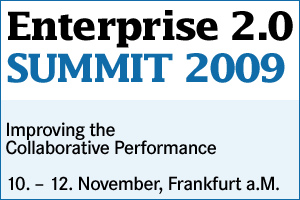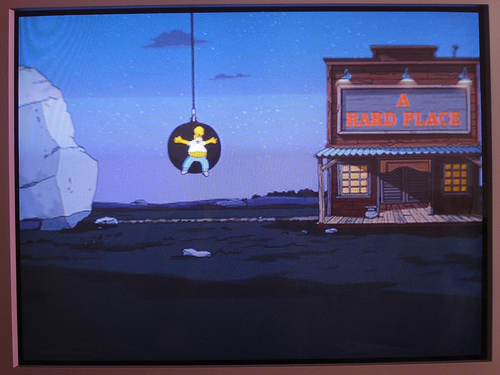 OK, now and right before LeWeb starts tomorrow it’s finally time to post the remaining parts of the summary posts on the E20SUMMIT. I mean, LeWeb will no doubt lead to an avalanche of posts and tweets, cleaning up all the drafts is essential preparation.
OK, now and right before LeWeb starts tomorrow it’s finally time to post the remaining parts of the summary posts on the E20SUMMIT. I mean, LeWeb will no doubt lead to an avalanche of posts and tweets, cleaning up all the drafts is essential preparation.
I’ve been looking back at the Wave use at the SUMMIT, at books and reports, and the social networking aspects of conferences, read people before – and I’ve already said that it’s been a good conference, with a lot of good discussions, and engaged people attending! We developed and discussed some great insights, and I want so say special thanks to all who contributed. Simon Wardley said that Enterprise 2.0 is a direction, not a state – and we’ve explored a bit of the road ahead together.
This is so necessary as Enterprise 2.0 in my view is a question of competitive advantage. And while you (and companies) don’t NEED to change, it’s a good idea to change and adapt proactively. Hence, Enterprise 2.0 thought leadership has to deal with the naysayers and the Crockologists – and this push-back is good because it forces us to think through our positions and lines of argumentation, to look at the subject from different angles and perspectives and to sharpen our understanding of both technologies and implementation approaches.
Of course there’s a place and rationale for Enterprise 2.0, and the many case studies provide ample support. Yet, we shouldn’t stop there and assume that uptake will happen naturally. It won’t – corporate resistance is real, thus finetuning Implementation and Adoption is important. Some learnings include that social it’s a bit of a tricky wording, like Andrew McAfee said during his keynote in San Francisco. Yes, words are important, and if you want to be effective it’s essential to test one’s own and the client’s understanding. Gil Yehuda argued that it’s a good idea to speak with the words your organization understands, ie. use the terminology that best resonates with the audience. And don’t use social or E20 like a mantra or mental short-cut, this will work only inside the E20 echo chamber. So we need to talk about tangible business values before we talk about technology, implementation or organizational change management. Yes, finding a non-IT team to run and foster the initiative is one good starting point. Plus, be not too picky about technologies or “solutions” – the best bet may lie in integrating different tools and let the usage emerge. We don’t want to recreate silos and “isolated effort” issues again, do we?
One of my take-aways has thus been that it’s incredibly hard to choose between a “start small – think big pilot” and a “skip the pilot” approach. Yes, it’s necessary to demonstrate quick successes – but both can work and both are potentiually risky, yet for different accounts. In the first case resistance may argue that E20 only works in this special small group of E20-geeks (are they the right ones to drive enterprise 2.0? Too many IT-people from Mars will alienate the business folks from Venus …), in the second case roll-out steps and ideas for more general adoption throughout the enterprise must be thought and budgeted ahead. In both cases the best idea seems to be really adaptable, and willing to employ various transition strategies and ideas. We’ve repeatedly learned that frontal assault is foolish – eg. fighting against email is alienating (on the contrary it should be used as a transition tool) and should be replaced by a more guerilla like adoption approach.
Yet, there are also a bit more manageable tasks and requirements. This arena comprises playing and integrating with established IT and corporate information systems. One major implementation effort and open task is enterprise search integration, being SOX compliant, and dealing with the various challenges and implications, concerns and sorrows for E2.0 deployments. The “cloud” (be it SaaS, hosted, etc.) in particular is tricky enough – see e.g. the EU Data Protection Directive and the questions of privacy it poses (yes, European perspective here, we’ve had lots of good discussions about the different challenges with E20 in Europe versus the US.)
[…] If you want to put data in the cloud that includes personal information of EU residents (and that might be something as simple as an email address or employment information), and the data will flow from the EU to almost anywhere in the world, you cannot simple throw the data in the cloud and hope for the best.
Another learning focusses on the discussions of measuring collaborative performance – the scheme of how to measure effectiveness vs. efficiency presented by Kjetil Kristensen was insightful and stressed that effectiveness of collaboration efforts is often overlooked and neglected. Yes, the value of collaboration is not collaboration itself (and sometimes you don’t people to collaborate at all, think Chinese Walls in investment banking etc.) – the values of communication and collaboration across hierachical levels and “official tasks” are various: Thinking together, not thinking alike should be the goal, while buidling up mutual understanding. Tricky, huh?
And here’s one link to the adoption and implementation issues from above: As knowledge and understanding of one companies’ vision of E20 is created in the conversation it’s essential to engage many stakeholders in the conversation, if only to connect the efforts with the actual business needs of the people. Gathering diverse perspectives and having meaningful conversations on the opportunities ahead ensures shared vision.
OK, now I’m off to Paris, it’s been kinda hard …
 Kleine Sünden werden direkt bestraft – nachdem ich gestern nicht nur ein Google-T-Shirt bekommen, sondern auch kritische Fragen beim Google Wave Workshop gestellt habe fehlt die Hälfte meiner Eingaben in die Dokumentationswave von Tag 1 der LeWeb …
Kleine Sünden werden direkt bestraft – nachdem ich gestern nicht nur ein Google-T-Shirt bekommen, sondern auch kritische Fragen beim Google Wave Workshop gestellt habe fehlt die Hälfte meiner Eingaben in die Dokumentationswave von Tag 1 der LeWeb …


 I’m stuck in the midst of conferences and end-of-year-accelerating projects, both adding to the workload (low-quality rock and the hard place picture of Homer ‘course copyrighted by Fox, obviously).
I’m stuck in the midst of conferences and end-of-year-accelerating projects, both adding to the workload (low-quality rock and the hard place picture of Homer ‘course copyrighted by Fox, obviously).